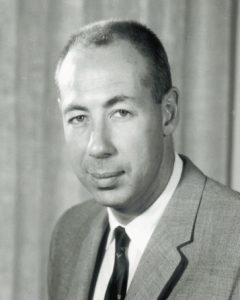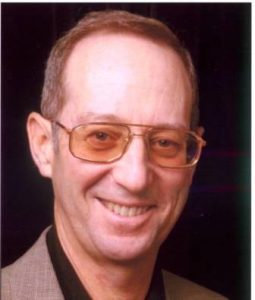 Research evolves into more formal program across Southern California
Research evolves into more formal program across Southern California
Dr. Sapin tapped as first physician director of Education and Research
 In the early 1970s, the medical group decided that the Department of Education and Research needed a physician leader.
In the early 1970s, the medical group decided that the Department of Education and Research needed a physician leader.
When Dr. Sapin heard about the potential opportunity, he wrote to the executive medical director to throw his hat into the ring. He got the job, becoming the first regional director of the Department of Education and Research in 1972. (Dr. Sapin shared his recollections on the early days of research during a series of interviews with writer Teri Allen between 2002 and 2014. Much of what we know about R&E’s history in the 1960s and 70s comes from those interviews and other materials he shared with Teri. Dr. Sapin died in 2021.)
To formalize the process of reviewing and approving research projects, he established research committees at each of the 5 KPSC medical centers at that time: Fontana, Los Angeles, Panorama City, Harbor City, and Bellflower.
“The medical center’s research committee was the first stop for a physician wanting to do research,” said Dr. Sapin. “The chairs of all the research committees would meet and discuss each project.”
To encourage physicians to conduct research and publish studies, the department’s newsletters regularly featured published studies around the region. The research spanned many areas, including cancer, cardiovascular disease, child and adolescent health, gastroenterology, maternal-child health, and medication safety and effectiveness.
One of the studies featured included a 1977 study led by Dr. Cooper called “Detection of Prostatic Cancer by Solid-Phase Radioiummunoassay of Serum Prostatic Acid Phosphatase,” which was published in the New England Journal of Medicine.
“This new test has been hailed as a potential major breakthrough in the early detection of prostatic cancer,” reported Dr. Sapin in the Research and Education Annual Newsletter. “Dr. Cooper is the founder of our research program. His latest contribution is only one of the many Jack has made to medicine, all also helping to develop our reputation as a dynamic and progressive medical group.”
Physicians continue research out of pure passion
 In the late 1970s most physicians still worked in their off hours to scientifically assess the best protocols for healing their patients.
In the late 1970s most physicians still worked in their off hours to scientifically assess the best protocols for healing their patients.
Robert S. Zeiger, MD, PhD, who joined SCPMG in 1976, recalls that, “as a physician, you were really on your own.” Physicians couldn’t obtain grants and get paid for the work at the time. Dr. Sacks recalls fighting to be able to use the one-half day a week of Education Time for research. But that time wasn’t enough to do any complex research.
Still, they found a way.
Dr. Zeiger said, “You did research out of the goodness of your heart, working nights and weekends.”
Dr. Zeiger and his colleague Michael Schatz, MD, an allergist in San Diego, began collaborating in 1977. At the time, the research department had few personnel and little grant administration experience. So, their first National Institutes of Health–funded projects, “Prevention of Allergic Disease in Childhood” and “Asthma in Pregnancy,” had to be administered by UC San Diego, where both were clinical professors.
The study funded by Dr. Zeiger’s first KPSC grant showed that a referral to an asthma specialist reduced emergency room visits for asthma relapses. From these beginnings, Dr. Zeiger and Dr. Schatz conducted many clinical trials on asthma funded by the NIH and participated as principal investigators and co-principal investigators for NIH asthma networks, including the Childhood Asthma and Management Program and the Childhood Asthma Research and Education Network.
The results from these studies and clinical trials led to treatments that have improved allergy and asthma care across the globe.
IRB established to protect patients
In 1979, the KPSC Institutional Review Board was formed in response to new federal regulations.
An Education and Research newsletter at the time stressed the importance of protecting the people who participate in research studies. “First consideration is the patient. The human research subject is considered a person first, a patient second, and as part of a study only if informed consent and other appropriate safeguards are met,” read the newsletter article. “Our organization’s Human Rights Committee (Institutional Review Board), which has federal approval and is mandated by both federal and state law, meets with the Regional Research Committee and looks at all research proposals from this perspective.”
The establishment of the KPSC IRB marked the beginning of a new era. To protect patient rights and privacy, applications could come only from researchers within the organization, such as physicians, nurses, pharmacists, and scientists. An application from a researcher outside of the organization could be considered but not approved without “sincere internal interest for an active liaison as well as publication authorship agreements.”
Eric Macy, MD, the current chair of the KPSC and Hawaii IRB, has served on the KPSC IRB since 1992 and been the KPSC IRB chair since 1999. He said that KPSC initially decided that not only the required federally funded research would be subjected to a higher level of scrutiny but that all research coming out of KPSC would have the same level of review, independent of the funding source.
“We’ve always had a very independent IRB in Southern California that takes its protection of individuals very seriously,” Dr. Macy said. “Our goal at Kaiser Permanente is not primarily research, but patient care. Research is important for our members, but our livelihood is not dependent on it, so we are careful not to put the rest of our organization at risk.”
Structural changes continue
In the early 1980s, the research program moved under the umbrella of the newly created Department of Clinical Services. Dr. Sapin was tapped as its associate medical director.
In 1983, he appointed Sheldon Wolf, MD, as the regional coordinator of research. At the time, 5 units fell under research: Clinical Research, Epidemiologic Research, Regional Research Laboratory, Medical Technologies/Practice Evaluation, and Health Services Research.
At the time, there were 2 dozen internally funded research projects each year, each taking an average of 1 to 2 years to complete. The intent of the internally funded projects, Dr. Sapin said, was to “pilot test promising research studies, which then may be funded by external agencies for more in-depth research.”
In 1988, the research program moved into its own department – the Department of Research & Evaluation – to expand the research portfolio and increase access to external funding.





